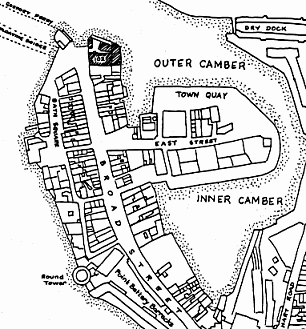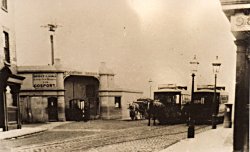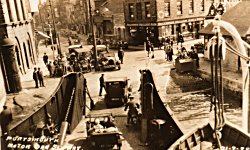
The Age of Steam
When the Borough Council declined to buy Point House in 1864, the decision was made at a Council meeting chaired by the Mayor, Richard William Ford who also happened to be the Secretary of the Port of Portsmouth and Ryde Steam Packet Company, which, within 6 months had placed the following notice in the Hampshire Telegraph:-
"The Packet Company have taken on lease the whole of the wharfs, stores, etc., now in the possession of Mr. Baker, Broad Street, Point. This accommodation, in addition to providing room for the repair of vessels will enable the company to have an office and board room on the same premises"

It was a propitious time for the house at Point to enter the history of the Packet Company. The previous few decades had seen much rivalry in the business of providing ferry services to the Isle of Wight and this was not resolved until 1851 when the two principal companies operating on the route merged to form the Packet Company. Expansion thereafter was rapid and the need for a single site for all their operations must have been urgent.
Henry Threadingham was born in Portsmouth. He was aged 32 when he was appointed as Superintendent for the Packet Company and given the house on the Point as his residence and office. He was unmarried at the time but with his new found status this quickly changed when he wed Mary who was at that time around 20 years of age. They had two children, Ada Mary and Alice Maud, aged 3 and 2 respectively according to the 1871 Census.

Henry was described as energetic and courteous, hard working and with enthusiasm for the improvement and prosperity of the Company. He was so successful in this that only 7 years had elapsed before the Hampshire Telegraph was reporting on a presentation made to Henry at a lavish dinner for 80 employees and shareholders of the Packet Company and other associated businesses. The toast of the evening was "Health and Prosperity to Mr. H. Threadingham", an honour occasioned by his careful supervision and attention to duty which was attributable, in a great measure, the success which had attended the business of the Company.
The Railway Companies Take Over
The following years were to see a clash of interests between the companies operating the ferry services and the two companies which had brought the railway into Portsmouth. The latter were exasperated at the difficulty of providing a through service to the Isle of Wight and secretly put together a plan to take over the Packet Companies which they succeeded in doing in 1881. Threadingham remained the ideal man to run the combined company's operations but he was already in ill-health and he died after only 4 years in his new post, on 25th January 1885. He was buried in Highland Road Cemetery in a grave that was re-used 30 years later, leaving Henry Threadingham with no permanent memorial.
Henry had already chosen his successor before he died and within a short time Robert Brown had taken over both the job and the house that went with it. He was 33 years old at the time and within 4 years had been appointed Marine Superintendent of the Joint Railway Company at a salary of £250 per annum. Brown had originally been an Engineer Officer for the Royal Mail Steamship Company but opted for a shore career after his marriage to Emily Louise. They had three children but two of them died in the house at Point, both aged twelve years.

Robert Brown was described as 'alert and resourceful' and that 'he was quite a success in his official capacity', but beyond that little is known of his work. He must have retired early as records show that by 1904 he was living at 91, St. Ronan's Road on £100 per annum as Consulting Superintendent of Boats. Emily died in 1925 aged 72 but Robert was to survive until a week before his 86th birthday in 1933. He was buried in Highland Road Cemetery.
On the retirement of Robert Brown, the post of Superintendent and residence of the house at Point passed to Alfred Fitz-Howard Drayson who had been in the employment of the joint railway company since 1890, shortly after he had retired from the Royal Navy in which he had served for 17 years. He was joined at Point House by his wife Aileen but by this time their only two children had both died. The Draysons were thought of as a good family, well educated and benevolent but they were always considered 'outsiders' by the local 'Pointers', possibly because of an inbuilt bias against Naval Officers whose responsibility for the Press Gangs two centuries earlier still rankled.
Drayson retired in 1913 and went to live in Brading on the Isle of Wight. He survived until 6th February 1945.
The last of the Marine Superintendents to live at the house was Alfred William Langworthy who took over in 1913, the culmination of a life devoted to the railways. He had started work in 1890 at the age of 15 as a parcels clerk at Ryde Pier and worked his way upward in the company until he came to work under Alfred Drayson, eventually succeeding him. Langworthy served a total of 25 years in the post during a period that saw massive expansion in the service and one world war. He retired in March 1938 with an annuity of £1000 but he had been preparing for this event in that he had bought a retirement home in Waterlooville and had moved there in 1935. Before leaving however he recommended that Thomas Sherwood be appointed as boatman/caretaker and be offered residency of the house an offer which would be extended when Langworthy's successor, C.T. Pelly decided he would not need the house as he wished to continue living in his house at Warblington.
Part 3 - Cynthia Sherwood remembers the House at Point